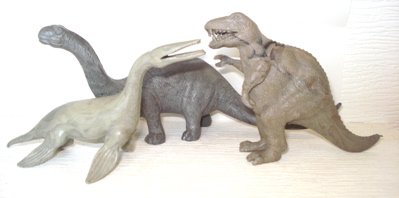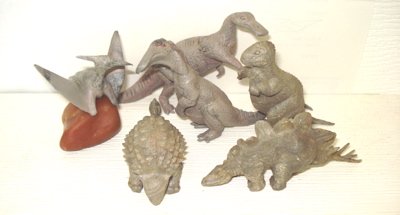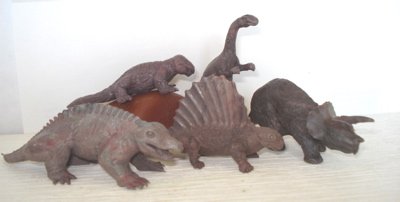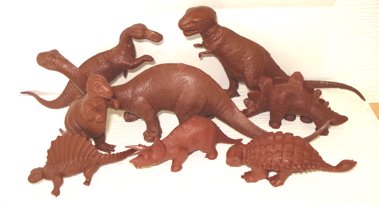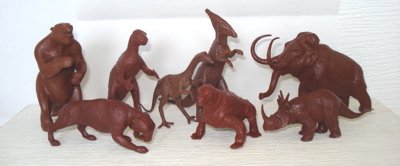|
This Marx Playset Monograph Offers a Brilliant Overview of an Iconic Toy Maker.Due to its length the Marx Playset Monograph will be continued on a second web page available by clicking on the link at the end of this page. Not Really Interested in "Marx-Playset-Monograph-Eye-Strain", Back To Marx Toys Then.... BUT. By Joe DeMarco and Mike Fredericks
Marx Dinosaurs and Playsets 1955 to 1970 Set Name: Marx The Creation of the Dinosaur Toys The history of Marx dinosaurs is a fascinating subject to dinosaur hobbyists but especially Marx fanatics. For many dinosaur enthusiasts and collectors, the Marx dinosaur models were the beginning of it all; the genesis for a lifetime of interest and passionate obsession of the intrigue of prehistoric life. Before these beautiful and important figures are described, it is an interesting history that tells of their creation. The Marx prehistoric animal line’s creator and designer had to fight for months to see his dream come to light. Frank Rice, Chief Designer for Louis Marx Toys worked at Marx headquarters on the 7th floor of 200 Fifth Ave in New York City. In the mid 1950s, dinosaurs were becoming popular in American culture and Frank, too, was interested in these strange creatures of long ago. Frank studied many historic figures in museums to give him ideas for new Marx playsets and the dinosaurs at the American Museum of Natural History in New York seemed like a good idea for a new Marx toy. Franks’ immediate boss was Ed Hjelte. These two men were responsible for creating extremely popular farm and western playset toys at this time and were always on the look out for another great seller. The men helped produce some very educational playsets and toys for America’s youth and took this responsibility seriously. The two men always had a list of possible new Marx playsets that they would put past their main boss, Louis Marx himself, at sales meetings. Frank had a hard time convincing anyone else at the meetings that a playset based on dinosaurs would sell. Dinosaurs were interesting enough for kids but with no “conflict” envisioned in a playset, the idea never went far as they felt it lacked play value. However, Louis Marx considered Phil Derham, the freelance sculptor that created many of Marx’s playset figures, a great asset to the company. “Louie” wanted Frank to keep Phil so busy that he would never be tempted to go work for another company. This is one of the reasons Marx was the creator of such a vast array of figures on so many subjects. Louie urged staffers to keep Phil on anything just to keep the other manufacturers away. Frank put Phil and his staff of sculptors onto the dinosaurs “just to keep them busy.” By 1955, the dinosaur idea finally gained some approval at the staff sales meeting thanks to the efforts of Frank. Three mold groups were brought out in 1955 with the intention of being sold as individual figures in dime store bins for 10 cents to 25 cents each. Dinosaurs had found their time, both at Marx and with the public and the figures sold well. The time for a dinosaur playset was still to come however. The Marx Playsets Didn't Just Happen, or Did They?
The Dinosaur Toys First Appear The beautifully painted display was such a hit at Toy Fair that retailers began asking for one to display their Marx dinosaurs in their stores. Frank realized that a large terrain piece like this would also help make up his dinosaur playset but the cost of producing one in plastic was much too expensive. The idea might have been forgotten if someone had not come up with the idea to vacuum-form the terrain piece. Vacuum forming was a new process but very inexpensive. A thin sheet of styrene plastic was heated and by using suction, pulled down over the plaster original to create a hollow copy. So, the terrain form went into production but, at this point, only as a store display for some 100 retailers where it greatly helped accelerate sales in toy stores. Next, the idea was reached to produce a small, inexpensive informational booklet about the prehistoric animals. Stores received a hundred or so as handouts and the booklet became an immediate sensation. To keep Derham busy, Frank next asked him to sculpt cavemen. Six tiny cavemen were produced, too small to be sold as bin items, but perfect to be included in a prehistoric playset. The terrain was now available and the booklet had tied cavemen in with dinosaurs even though a chronological timetable showed that man existed much later. Kids could now create the “conflict” by battling dinosaurs and tiny cavemen. Marx produced the cavemen in a creamy white to suggest they lived in caves and rarely saw sunlight. They were also created in tan and rarely in red brown and gray. With the figures, the terrain base, the booklet and a few palm trees and ferns added, all the elements for a successful Marx playset had now come together. In 1957, the Marx Prehistoric Times dinosaur playset hit store shelves and was a phenomenal success. The Dinosaur Toys: Unlike today’s lavish scale-model reproductions, the Marx dinosaurs were released by mold groupings. They are not single pieces. It is important to understand what pieces belong to these groups and their relationship to each other before we get into an in-depth description and history. The Marx Playset Monograph continues: Each Marx mold was given a number noted below in parenthesis. To current knowledge, the Marx molds can be delineated as follows:
Some More VariationAnother variation in this era is what Marx described as “mottled” coloring. A second or sometimes additional color was swirled in with the normal gray or even green. Frank Rice says that the swirls were intended to simulate jungle shadows and shading on the creatures. The resulting figures were very sparingly distributed throughout the prehistoric playsets and are prized by collectors. The available amount of waste plastic was ground and sometimes re-melted and drizzled into the molds. It saved on plastic but was sparingly done because the right color of plastic was rarely available at the right time a dinosaur was being cast; and the polyethylene, in general, did not take well to total recycling. Marx released a bevy of playsets during the subsequent years with different production numbers, but all were a variation of these two aforementioned sets to most degrees. At the same time, Marx continued their sales of individual dinosaurs in stores. But, now, they were sold in shades of brown, gray and green. The metallic green and silver pieces as well as the chocolate milk brown, to most accounts, were never sold as individual pieces. These were playset premium pieces only and, today, are quite rare. The Marx Playset Monograph - Revisionism When Marx introduced the sleek T-Rex circa 1959, they produced an entire new mold group of dinosaurs. ( The revised mold PL-977) With the exception of the sleek Rex, all other dinosaurs are the same as their original brethren with minor exceptions. Why did Marx create a new slimmer T-Rex figure and eventually stop production of their “Pot-bellied” T-Rex altogether? Frank Rice says that as a bin item, the original Tyrannosaurus was fine but to make a profitable playset, speed was important. Thousands of pieces of an item had to be made in the shortest possible time. While other mold groups were dry in a matter of a few seconds, the big T-Rex took much longer to set up. On top of his longer injection molding time, his curing time was taking too long. It was never a matter of saving plastic, as some collectors have surmised but instead, it was the importance of saving time and putting sets together efficiently. It is assumed, for the same reason, other figures were changed or abandoned too and revised mold groups were created. It was reported that the main reason the revised figures were created and have small differences from the original ones, was that the original figures used to create the first mold were slightly worse for wear, and had to be "touched up" when using them to make the revised mold. A hand's web detail lost on Trachodon, a leg fixed on Anky, etc. The revised ones always have less detail in the area of the fix. Known pictures of some of these original figures that were sculpted to be used to create the mold do indeed have little bits of damage in the extremities. The Revisions A description of the mold “revisions” from the revised blister card pieces and their identifying marks are as follows: 1. T-Rex: This is the easiest revision because the dinosaur is a completely different pose. The original T-Rex is fondly known as the Pot-Bellied T-Rex because of his robust stomach. The sleek T-Rex or “revised” Tyrannosaurus Rex is more in tune with the scientific vision of what we know a T-Rex looks like by today’s vision and is more animated and fearsome. 2. Brontosaurus: The original Brontosaurus is near identical to the revision. The original piece has 4 large mold circles on its feet and the descriptive words on the animal are large, crisp and higher up on the abdomen. All revised Brontos have small mold circles on its feet and the descriptive words are small and on the very underbelly of the dinosaur. This and most revised mold pieces have a slightly shinier texture, as well. 3. Trachodon: Original Trachodons have their forepaw pointing downward. This piece is slightly unbalanced and tends to lean to the left. Revised Trachodons are perfectly balanced and the forepaw extends upward. 4. Stegosaurus: Original Stegos have a single large mold circle on the left foot. The other 3 feet will have small mold circles. The revisions have a small mold circle on all 4 feet, or in some instances, no mold circles at all. 5. Ankylosaurus: The revised Anky is slightly slimmer with smaller legs but the easiest way to discern the pieces is by looking at the underbelly. Originals have a pebbly texture and revisions have a grid like pattern. 6. Triceratops: Again, the revision is slightly smaller in girth but original Trikes have thicker and firmer horns. The revision has flimsy, thin horns. 7. Allosaurus: The revised Allo has his paws tucked further under than the originals. Also, all Allosaur originals lean in an unbalanced posture. The revisions have perfect balance and all toes on the feet point straight forward. 8. Dimetrodon: The only visible difference in these 2 is the revised Dimetrodons do not have a mold circle on the underbelly. All originals have a faint mold circle on the underbelly. These 8 figures were only known to be sold as a group on blister cards and in post 1961 playsets. With the advent of the “revised” group of 8, Marx then took the original large mold group (PL-749) out of production. Although it was done as a conscious effort to increase production it unfortunately also removed one of their most popular creatures in the Kronosaurus. Because of this marketing ploy, most often the Pot-Belly Rex and Kronosaurus tend to be in lesser number and higher demand than most other Marx models...and especially exist in less diversity of color. The eight revised pieces, additionally, seem to be the most common of the Marx original figures as they were sold in abundance during Marx’s peak popularity. Plus, it was probably thriftier to buy a set of eight pieces together than pick them out one at a time, especially since most folks, it is assumed, would have wanted the new T-Rex. The Rarest Marx Playset is Born (Hatched?)The Marx Playset Monograph: Focus on Playsets This set is incredibly rare and offers, arguably, the best and most dynamic box art ever created on a playset. It’s colorful in vivid green and black ink and catches the eye like none other before or since. The box is odd shaped at 9x14 inches and depicts a bellowing Pot Belly Rex on one side of a stream and a gazing Brontosaurus and Kronosaurus on the far side. There’s a bevy of cavemen depicted on the box as well and a stray Dimetrodon. The set contents are rather meek and seem consistent from few known sets, one gray and one green Sphenodocons, 2 gray and 2 green Dimetrodons, 2 gray and 2 green Plateosaurs, 1 gray and 1 green Triceratops, 1 gray and 1 green Cynognathus, 1 gray Allosaur, 1 gray Stegosaur, 1 gray Pteranodon, 1 gray Ankylosaur, 1 gray Hadrosaur, 1 gray Trachodon, 1 green Pot-Belly T-Rex, 1 green Bronto, 1 green Krono, one flat rock formation from the #3388 series, two palms, four ferns and a set of six cavemen in the rare linen color. But it’s the box in this set which commands attention. Only a few known versions of this set exist intact and it’s an item to be cherished. Shortly after this release another rare smaller set was put into production called the “Marx Prehistoric Playset #0645.” It’s another super rare item but does not carry the wallop of the aforementioned #2650. This set too has rather unique box art depicting eight Marx dinosaurs in light green and black litho on a 6 and half by 14 inch box. The box is not made of the sturdy corrugated cardboard of most other Marx boxes and tends to be torn or have tattered edges when found today. The box actually reveals the set contents inside; revised T-Rex, Brontosaurus, Allosaurus, Stegosaurus, Ankylosauurs, Dimetrodon, Allosaurus and Trachodon with one tree and two ferns. There are no rock formations, cavemen or booklet. It’s actually a revised card set in playset form and was perhaps released to simply promote the revised card pieces. In late 1961 Marx also released a second (and new) set of blister carded figures. These are known as the second series pieces (PL-1083) and came carded as a group entitled “Monsters and Mammals.” The advent of this set of eight brought on the addition of yet another standard, but less common Marx dinosaur color, that being tan. These pieces can often be found in the very desirable tan color on the blister cards. It is believed that the second series carded sets of Marx pieces were also never sold as individuals but only as a carded set or as a part of the #3398 playset mentioned below. This carded set also oft times had the dinosaurs in metallic green coloring. They are rare indeed and the metallic of this green shade is shallower than the original metallic from the #3390 playsets. But both versions of color remain uncommonly rare to this date. It was 1963 when Marx released the granddaddy of all playsets. The “#3398 Prehistoric Times Playset” included all Marx dinosaurs and cavemen except the original large mold group (PL-749). There are 57 total pieces in this set, 36 of which are dinosaur pieces. This is probably the rarest and most desirable of the large sets to seek and find among collectors today. A major change in marketing was the addition of a new interlocking 3 piece mountain-lake set with land bridge (which came in brown or marbled brown), 12 cavemen (6 tan and 6 cream), all the trees and ferns, and a new revised booklet. The large 12x24 inch box depicts the revised T-Rex walking through a time tunnel of concentric circles. This is probably the most sought after of all Marx playsets today. The box alone is the quest of many a collector. The #3398 set usually contained the medium mold group in the very desirable tan or chocolate milk brown colors. This is an extremely rare set of pieces in either color shade. The second series (PL-1083) figures were usually a reddish brown color in this set. This is the only Marx playset which contains the second series pieces and the revised mold pieces in total. This set represents the pinnacle of Marx production. The Marx Playset Monograph: A New Plastic Shortly thereafter, according to rumor, the U.S. government mandated the lead pigment be removed from the color in the Marx plastic for safety reasons. The resultant product was a waxy, shiny plastic and an inferior quality dinosaur. Surviving Marx production workers today insist this is a false rumor and explain that the switch to glossier style plastic allowed the figures to eject from the molds more easily. Marx had actually used this waxy plastic in a few of their non-dinosaur playsets as early as the late 1950s. Marx Playset Monograph: The Nuremberg Toy Fair The year 1963 also ushered in one of Marx’s most desired releases. The Nuremberg Toy Fair in Germany sold the original 14 Marx dinosaurs in hard plastic painted form. The actual manufacture of these is not known although they are Marx products. It is assumed they were produced in the American Marx plants but could well have been from the Japanese plants. Finding Marx in hard plastic is a rarity but complete original issuance sets is almost unheard of. The Nuremberg pieces are painted, as well, giving the Marx production an added definition and scope. It’s a welcomed variation on a theme. A recent warehouse find of the hard plastic pieces were sold via ebay outlets a few years ago but the stock quickly vanished and despite the brief glut, the Nuremberg pieces are still considered uncommonly rare. Marx Playset Monograph: On Color Matching Original Marx dinosaurs remain in great demand even today. These are the collectibles by which most other modern day models are judged. Collecting Marx is almost considered an art form and is usually done by set and then, after that achievement, most Marx fanatics will look to color as a priority for collecting. Re-finding a childhood playset in acceptable condition is a crowning achievement in collecting. Collecting color matched Marx sets is the passion! When attempting to color match Marx models it is important to keep in mind how extremely difficult this task can be. Keep in mind, the Marx dinosaurs were produced by mold groupings as outlined prior. So, the mold-mated dinosaurs “must” be consistent in color. In other words, if one piece of a mold is found in a certain color, then they will all exist in that color. Because the dinosaurs were produced on five different molds, color matching them perfectly is a challenge. The only way to insure absolute “perfect” color matching is to find the mold grouping pieces in a playset. Individual pieces tended to vary in shade greatly. In the case of Marx, the standard green color has a wide but subtle range in variance. Additionally, it is important to note that not all Marx dinosaurs were produced in every color. A Brief Overview on Color The Marx Playset Monograph Notes on Coloration Large Mold Group (PL-749): Most common color is gray. Also abundant in green. This color was never molded in basic and darker brown but is the only group to exist in silver. Also, this group was molded in a very light shade of chocolate milk brown but it is extremely rare. Never made in tan but was made in metallic green in rare numbers. Medium Mold Group (PL-750): Common color is grays and greens. This group was also never done in basic and dark brown but does exist in rare numbers in chocolate milk brown. This group was made in tan in the #3398 playset only and is a premium color. Never made in metallic green or silver. Small Mold Group (PL-755): Most common color is standard greens. Also abundant in grays and available in lesser numbers in browns. Never made in tan or metallic green or silver. Revised Mold Group (PL-977): Also came in most every Marx color, including metallic green. Rumored to exist in tan but there are no known tan versions. Never made in silver. Second Series Mold Group (PL-1083): This group was made in most colors including tan. This group even exists in a slightly different shade of metallic green. Most common color is brown and gray and standard green is the least common of the regular Marx colors. Not made in silver.
This discussion relates to the standard colors Louis Marx permitted for the production of his dinosaur models. Many hours were spent determining which color kids would find desirable. It appears the Marx philosophy was based on conservatism. For that reason, Marx tended to stick to earthier tones in their original figures. But, one of the critical things that made Marx so popular, besides the perceived color of the figures, was the mere quality of its product. (Motto: "Quality is NOT Negotiable!"-BJ) Unlike MPC, Tim-mee and Ajax, Marx had very strict quality control and production standards. But, one of the outcrops of this strict quality control was what should be done with the resultant garbage or molding errors? The DUMP!!The Dinosaur Toys Collectors Guide Loves the Dumposaurs (The Marx Playset Monograph discusses The Dump) As you may or may not know, the Marx dinosaurs were produced in injection molding machines. These machines, apparently, are not generally conducive to reusing plastic so virgin plastic had to be used for virtually each and every run of dinosaurs produced. Recycling was not an option. Anything that did not come out to pre-set standards, be it due to mis-molding, short-molding or even color disparaging had to be thrown out according to the Louis Marx bylaws. Needless to say that came to be quite a stash of trash items considering the many many years Marx was in business. What makes this quality control all the more intriguing is Marx did not burn its plastics. They simply buried them in the now infamous Marx Toy Dump which is located about 20 miles outside of Moundsville, West Virgina. This large landfill area is (was) the home for a glorious array of discarded Marx toys. Now, keep in mind, this not only consisted of dinosaurs, but every single Marx plastic mold ever produced. Daily, thousands and thousands of pieces were discarded and dumped and buried and covered over. But, as long as Marx was in business, the dump was a moot area. Owned and operated by the Marx Toy company it was off limits to outsiders. When Marx went out of business in the late 1970’s so did the reluctance to take a pick and shovel and visit the dump area. Going on a paleontological dig was no longer limited to the paleontologists with a true fossil mission. The collector, with his own passion and appreciation for “fossil toys” could make his own dig. As in real life fossil hunting, this, in most cases, could be a fruitless venture. The landfill area is on an expansive tract of land and hitting a dumped area would be akin to finding a T-Rex fossil lying openly in a desert bed of sand. But humans and especially toy collectors are quite obsessive. What lies below the grounds in West Virginia was a mystery and we all know, human beings love a good mystery. A few failures never dissuaded any passionate toy collector. A trip to the Marx dump can be quite a revealing experience. Although now located on public lands, the dump is only accessible by passing through private properties. Landowners in the area know the ramifications which lie therein, so passage is no easy task. Most landowners sit with guns perched for any passers by. It takes quite a stipend to get through, but if you are one of the lucky few that know the bribery bylaws well enough to get by, and if you are one of the lucky few that knows where to dig, a mother lode could be the results of the effort. Found in the dump in recent years have been dinosaurs of the most unusual and glorious color. To collectors they are like gold. Obsessive Marxists thinking that had collected all that existed in Marx were introduced to an entire new realm of color. Fanatic collectors had to start all over and the gold rush was on! Not all were and are gems. There is the usual complement of mold mishaps...prehistoric thalidomide creatures with chests attached or legs and arms missing sink spotted pieces or tails that are short molded. In fact, the first foot or two of digging reveals plastics that are virtually rendered useless by the effects of weathering. Underneath, however, lays the gold. Untouched, often pristine pieces have been found which were discarded simply because of color. Beautiful robins’ egg blue pieces have been found in abundance in absolutely mint condition, the more moody moss green shades are plentiful and the combo shades as a result of paint mixing are overwhelming. Brownish grays, grayish greens, muddy browns and brown like tans lie buried, in addition to varied multi-colored pieces. All of these are presumably as a result of a color change in molding or experimenting by bored Marx staffers. All of these, for whatever reason, were nothing but trash in the 1960’s. But one man’s garbage in 1960 is another mans gold years later. Marx fans claim collecting Marx dinosaurs is a re-kindling of the creative and inquisitive spirit we had as kids. Each Marx model, in its own right, conjures up memories from a childhood experience. Each piece has its own charm and unique place in our collective lives. The leaded plastic has a distinctive odor which Marx collectors find intoxicating. Each dinosaur and each color has its own special meaning to remind us of where we were or what we were precisely doing at some time in our long ago past. And for that reason, the spirit of childhood, of recapturing youth is forever tied into these glorious models which helped form our youths and the basis and foundation of what makes Marx dinosaur collectors what they are today. The #3398 playset was the last Marx playset production in the 60’s decade and also, sadly, an end of an era. (This Marx Playset Monograph is just Chock Full o' Facts) To Part Two of the Marx Playset Monograph: Click Here
We here at The Dinosaur Toys Collectors Guide have only one purpose in being here at all. Providing you, our readers, with the best, most informative and entertaining information about Dinosaur toys both past and present.
In order to best achieve that goal, in addition to providing pages on individual figures, advice and suggestions on obtaining the Dinosaur toys and pricing, availability and age and personality appropriateness information.... We have instituted our: 1) The (easily subscribed to, FREE) Daily "Dino-Blog" where you are regularly updated as each new page is created and kept up-to-date on Dinosaur toys news and the happenings in "Dino-town." 2) Our Contact-osaur-Us form which you can use to send us comments and tell us what you need and want to see. After all, this site is for your information. 3) Social Networking links (way bottom, upper left) so you can share this page, and our site, with your friends. Thank you. 4) Our mighty and inimitable Search-osaurus Center. (Click link or Below.) You can use the search bars to either search the site for all things Dinosaur (toys) or search the entire web for all things anything at All-a-saurus. Search-O-Saurus Center You can use this site-search box to find everything you need about Dinosaur toys collecting. Can't remember everywhere we mentioned, say, Velociraptors or Diplodocuses? Just put in your search term and you'll get a listing of everyplace on our site where you can find what you are particularly interested in.

Custom Search
Please note that your search results page will have ads ABOVE and BELOW the actual search results. Those are not from the site, but should be of interest, since Google targets the ads to your particular search. Marx Playset Monograph, Marx Playset Monograph, Marx Playset Monograph, Marx Playset Monograph, Marx Playset Monograph, Marx Playset Monograph, Marx Playset Monograph, Marx Playset Monograph, Marx Playset Monograph, Marx Playset Monograph, Marx Playset Monograph, Marx Playset Monograph, Marx Playset Monograph, Marx Playset Monograph, Marx Playset Monograph, Marx Playset Monograph, Marx Playset Monograph, Marx Playset Monograph, Marx Playset Monograph, Marx Playset Monograph, Marx Playset Monograph, Marx Playset Monograph, Marx Playset Monograph, Marx Playset Monograph, Marx Playset Monograph, Marx Playset Monograph, |
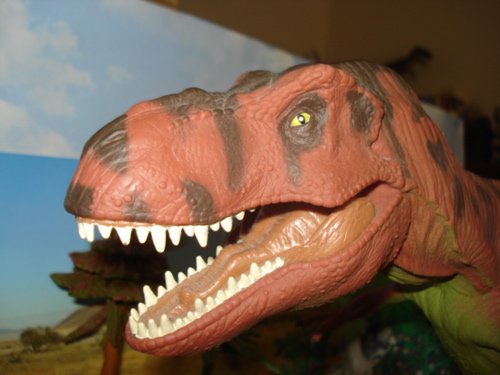
And I'll get back to you as soon as I can. Right after I've had a snack.
Pin-a-Picture-Any-Picture

Follow-Rexford-on-Pinterest
To go to AMAZON for All Things Dinosaur click here.
There will be Amazon links to particular Dinosaur Toys on their personal pages!



